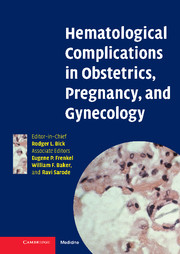Book contents
- Frontmatter
- Contents
- List of contributors
- Preface
- 1 Disseminated intravascular coagulation in obstetrics, pregnancy, and gynecology: Criteria for diagnosis and management
- 2 Recurrent miscarriage syndrome and infertility caused by blood coagulation protein/platelet defects
- 3 Von Willebrand disease and other bleeding disorders in obstetrics
- 4 Hemolytic disease of the fetus and newborn caused by ABO, Rhesus, and other blood group alloantibodies
- 5 Hereditary and acquired thrombophilia in pregnancy
- 6 Thromboprophylaxis and treatment of thrombosis in pregnancy
- 7 Diagnosis of deep vein thrombosis and pulmonary embolism in pregnancy
- 8 Hemorrhagic and thrombotic lesions of the placenta
- 9 Iron deficiency, folate, and vitamin B12 deficiency in pregnancy, obstetrics, and gynecology
- 10 Thrombosis prophylaxis and risk factors for thrombosis in gynecologic oncology
- 11 Low molecular weight heparins in pregnancy
- 12 Post partum hemorrhage: Prevention, diagnosis, and management
- 13 Hemoglobinopathies in pregnancy
- 14 Genetic counseling and prenatal diagnosis
- 15 Thrombocytopenia in pregnancy
- 16 Neonatal immune thrombocytopenias
- 17 The rational use of blood and its components in obstetrical and gynecological bleeding complications
- 18 Heparin-induced thrombocytopenia in pregnancy
- 19 Coagulation defects as a cause for menstrual disorders
- Index
- Plate section
- References
13 - Hemoglobinopathies in pregnancy
Published online by Cambridge University Press: 01 February 2010
- Frontmatter
- Contents
- List of contributors
- Preface
- 1 Disseminated intravascular coagulation in obstetrics, pregnancy, and gynecology: Criteria for diagnosis and management
- 2 Recurrent miscarriage syndrome and infertility caused by blood coagulation protein/platelet defects
- 3 Von Willebrand disease and other bleeding disorders in obstetrics
- 4 Hemolytic disease of the fetus and newborn caused by ABO, Rhesus, and other blood group alloantibodies
- 5 Hereditary and acquired thrombophilia in pregnancy
- 6 Thromboprophylaxis and treatment of thrombosis in pregnancy
- 7 Diagnosis of deep vein thrombosis and pulmonary embolism in pregnancy
- 8 Hemorrhagic and thrombotic lesions of the placenta
- 9 Iron deficiency, folate, and vitamin B12 deficiency in pregnancy, obstetrics, and gynecology
- 10 Thrombosis prophylaxis and risk factors for thrombosis in gynecologic oncology
- 11 Low molecular weight heparins in pregnancy
- 12 Post partum hemorrhage: Prevention, diagnosis, and management
- 13 Hemoglobinopathies in pregnancy
- 14 Genetic counseling and prenatal diagnosis
- 15 Thrombocytopenia in pregnancy
- 16 Neonatal immune thrombocytopenias
- 17 The rational use of blood and its components in obstetrical and gynecological bleeding complications
- 18 Heparin-induced thrombocytopenia in pregnancy
- 19 Coagulation defects as a cause for menstrual disorders
- Index
- Plate section
- References
Summary
Introduction
All human hemoglobin is composed of two α-globin-like chains and two non-α-globin chains that combine to form a tetramer. Normal adults have three hemoglobin types, HbA (α2β2; ∼ 96%), HbF (α2γ2; ∼ 1%), and HbA2 (α2δ2; ∼ 3%). The amino acid sequence, or primary structure of each globin chain differs; dissimilarities between α- and non-α-globin chains are greater than the variations among the globins of the β-like gene cluster, e.g. γ-, δ-, and β-globin. Despite these differences among globins their similarities are even greater as all have alike secondary and tertiary structure and function similarly. Human hemoglobin is ideally suited for its tasks – primarily oxygen uptake in lungs and delivery in tissues. A sigmoidal shaped curve, so critical for this oxygen transport, is a result of the interactions among the individual globin subunits of the tetramer. As for hemoglobin function, the sigmoidal shape of the oxygen dissociation curve of hemoglobin shows that totally deoxygenated hemoglobin is slow to become oxygenated, but as oxygenation proceeds, the reaction of heme with oxygen accelerates; the reverse is also true. Hemoglobin has other functions in CO2 exchange and control of vascular tone by nitric oxide (NO) and can modulate oxygen delivery by shifts in its oxygen-hemoglobin dissociation curve caused by temperature, pH, and organic phosphates.
Different classes of mutations can alter the structure, function, and synthesis of hemoglobin. More than 1,000 structurally abnormal hemoglobins have been characterized and the number of thalassemia-causing mutations exceeds 200.
- Type
- Chapter
- Information
- Publisher: Cambridge University PressPrint publication year: 2006
References
- 2
- Cited by



